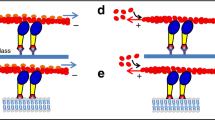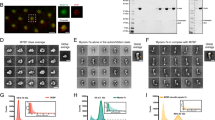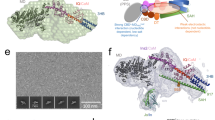Abstract
Myosin VI is a molecular motor that can walk processively on actin filaments with a 36-nm step size. The walking mechanism of myosin VI is controversial because it takes very large steps without an apparent lever arm of required length. Therefore, myosin VI is argued to be the first exception to the widely established lever arm theory. It is therefore critical to directly demonstrate whether this motor walks hand-over-hand along actin despite its short lever arm. Here, we follow the displacement of a single myosin VI head during the stepping process. A single head is displaced 72 nm during stepping, whereas the center of mass previously has been shown to move 36 nm. The most likely explanation for this result is a hand-over-hand walking mechanism. We hypothesize the existence of a flexible element that would allow the motor to bridge the observed 72-nm distance.
This is a preview of subscription content, access via your institution
Access options
Subscribe to this journal
Receive 12 print issues and online access
$189.00 per year
only $15.75 per issue
Buy this article
- Purchase on Springer Link
- Instant access to full article PDF
Prices may be subject to local taxes which are calculated during checkout




Similar content being viewed by others
References
Aschenbrenner, L., Lee, T. & Hasson, T. Myo6 facilitates the translocation of endocytic vesicles from cell peripheries. Mol. Biol. Cell 14, 2728–2743 (2003).
Buss, F. et al. Myosin VI, a new force in clathrin mediated endocytosis. FEBS Lett. 508, 295–299 (2001).
Wells, A.L. et al. Myosin VI is an actin-based motor that moves backwards. Nature 401, 505–508 (1999).
Avraham, K.B. et al. The mouse Snell's waltzer deafness gene encodes an unconventional myosin. Nat. Genet. 11, 369–375 (1995).
Cramer, L.P. Myosin VI: roles for a minus end-directed actin motor in cells. J. Cell Biol. 150, F121–126 (2000).
Altman, D., Sweeney, H.L. & Spudich, J.A. The mechanism of myosin VI translocation and its load-induced anchoring. Cell 116, 737–749 (2004).
Lister, I. et al. A monomeric myosin VI with a large working stroke. EMBO J. 23, 1729–1738 (2004).
Purcell, T.J., Morris, C., Spudich, J.A. & Sweeney, H.L. Role of the lever arm in the processive stepping of myosin V. Proc. Natl. Acad. Sci. USA 99, 14159–14164 (2002).
Rief, M. et al. Myosin-V stepping kinetics: a molecular model for processivity. Proc. Natl. Acad. Sci. USA 97, 9482–9486 (2000).
Spudich, J.A. The myosin swinging cross-bridge model. Nat. Rev. Mol. Cell Biol. 2, 387–392 (2001).
Spudich, J.A. How molecular motors work. Nature 372, 515–518 (1994).
Rock, R.S. et al. Myosin VI is a processive motor with a large step size. Proc. Natl. Acad. Sci. USA 98, 13655–13659 (2001).
Forkey, J.N., Quinlan, M.E., Shaw, M.A., Corrie, J.E. & Goldman, Y.E. Three-dimensional structural dynamics of myosin V by single-molecule fluorescence polarization. Nature 422, 399–404 (2003).
Yildiz, A. et al. Myosin V walks hand-over-hand: single fluorophore imaging with 1.5-nm localization. Science 300, 2061–2065 (2003).
Bahloul, A. et al. The unique insert in myosin VI is a structural calcium-calmodulin binding site. Proc. Natl. Acad. Sci. USA 101, 4787–4792 (2004).
Nishikawa, S. et al. Class VI myosin moves processively along actin filaments backward with large steps. Biochem. Biophys. Res. Commun. 290, 311–317 (2002).
Berger, B. et al. Predicting coiled coils by use of pairwise residue correlations. Proc. Natl. Acad. Sci. USA 92, 8259–8263 (1995).
Rice, S. A Structural Change in the Neck Region of Kinesin Motors Drives Unidirectional Motility. Thesis, Univ. of California San Francisco (2001).
De La Cruz, E.M., Ostap, E.M. & Sweeney, H.L. Kinetic mechanism and regulation of myosin VI. J. Biol. Chem. 276, 32373–32381 (2001).
Yildiz, A., Tomishige, M., Vale, R.D. & Selvin, P.R. Kinesin walks hand-over-hand. Science 303, 676–678 (2004).
Veigel, C., Wang, F., Bartoo, M.L., Sellers, J.R. & Molloy, J.E. The gated gait of the processive molecular motor, myosin V. Nat. Cell Biol. 4, 59–65 (2002).
Mehta, A.D. et al. Myosin-V is a processive actin-based motor. Nature 400, 590–593 (1999).
Sweeney, H.L. et al. Kinetic tuning of myosin via a flexible loop adjacent to the nucleotide binding pocket. J. Biol. Chem. 273, 6262–6270 (1998).
Rock, R.S., Rief, M., Mehta, A.D. & Spudich, J.A. In vitro assays of processive myosin motors. Methods 22, 373–381 (2000).
Acknowledgements
We thank B. Spink for assistance in the creation of the construct and H.L. Sweeney for providing the plasmid for myosin VI expression. We thank F. Müller-Planitz for assistance in MatLab programming, helpful discussions and comments on the manuscript. We also thank D.A. Altman and A. Dunn for helpful discussions and comments on the manuscript. This work was supported by Boehringer Ingelheim Fonds to Z.Ö., US National Institutes of Health grant GM33289 to J.A.S. and a Burroughs Wellcome Career Award at the Scientific Interface to R.S.R.
Author information
Authors and Affiliations
Corresponding author
Ethics declarations
Competing interests
The authors declare no competing financial interests.
Supplementary information
Supplementary Fig. 1
Inchworm model. (PDF 181 kb)
Supplementary Fig. 2
Titration curve. (PDF 20 kb)
Supplementary Fig. 3
Labeling specificity. (PDF 26 kb)
Supplementary Fig. 4
Single photon localization. (PDF 143 kb)
Supplementary Video 1
An example of a myosin VI motor that is walking close to the evanescent field can be seen at the top of the image. This molecule appears bright as opposed to the molecules walking on fully suspended filaments (see Supplementary Video 2). Most molecules do not walk this close to the surface. Superimposed and artificially colored images of Cy5 labeled Myosin VI (green) and actin (red). (AVI 1733 kb)
Supplementary Video 2
An example of a myosin VI motor that is walking on a fully suspended filament can be seen at the top right hand corner. Most Cy5 labeled myosin VI molecules on the fully suspended filaments far away from the evanescent field appear too dim to yield the required resolution for measuring the step size. (AVI 1608 kb)
Rights and permissions
About this article
Cite this article
Ökten, Z., Churchman, L., Rock, R. et al. Myosin VI walks hand-over-hand along actin. Nat Struct Mol Biol 11, 884–887 (2004). https://doi.org/10.1038/nsmb815
Received:
Accepted:
Published:
Issue Date:
DOI: https://doi.org/10.1038/nsmb815
This article is cited by
-
Rotation-translation coupling of a double-headed Brownian motor in a traveling-wave potential
Frontiers of Physics (2021)
-
Single molecule fluorescence spectroscopy for quantitative biological applications
Quantitative Biology (2016)
-
Measuring the Limping of Processive Motor Proteins
Journal of Statistical Physics (2011)
-
Single-molecule stepping and structural dynamics of myosin X
Nature Structural & Molecular Biology (2010)
-
Myosin VI: an innovative motor that challenged the swinging lever arm hypothesis
Nature Reviews Molecular Cell Biology (2010)



